April 08, 2020 0 Comments
Last week, we shared Episode #1 of Chef Jim Noble's new YouTube cooking series, featuring our popular Heritage Poulet Rouge® Chicken.
Today we have episode #2, where Chef Noble shows how to grill up some delicious, thick ribeye steaks, cut from a Joyce Farms whole grass-fed ribeye.
Check out the video below! And, learn more about our Grass-Fed Heritage Beef here.
April 03, 2020 0 Comments
By Dr. Allen R Williams, Ph.D.
We often think of ourselves as a single organism called a person. However, we are actually made up of a dazzling array of parts (arms, legs, ears, nose, eyes, etc.) and pieces (heart, liver, kidneys, pancreas, stomach, intestines, etc.). Somehow all these parts and pieces function as one intact organism, or so we believe.
There are actually tiny, microscopic organisms that live in our gut, our mouth, our skin and many other places in our bodies. How many? More than 100 trillion of them.
We have more microorganisms living on us and in each of us than the size of our national debt. Together, all these microorganisms are known as the human microbiome and they are ten times more numerous than the number of cells in our body.

It is said that we are actually our own personal ecosystem, and just like damaging the world’s ecosystem has disastrous effects on human life, damaging our personal ecosystem has disastrous effects on our lives and long-term health also.
Just how important are these 100 trillion microbes? Well, take them away and we die. It is that simple. We cannot survive without our personal microbiome.
This personal ecosystem regulates our digestion, our detoxification process, our absorption of nutrients, our brain function, endocrine gland function, organ function, skin function, the synthesis of essential nutrients and vitamins. Our microbiome is intricately linked to every aspect of our health. From heart disease to diabetes to arthritis to obesity to Alzheimer’s.

Depiction of Microbes in the Human Gut
Let me provide just a little more perspective. The human genome is comprised of about 23,000 genes. Our extended genome, or non-human genome, provided by the trillions of microbes living on us and in us, extends our genome by millions of genes. In our gut alone we have more than 40,000 bacterial species with 9 million unique bacterial genes and over 100 trillion microbial cells. We are far more diverse than a rain forest!
Want to lose a quick 5 pounds? Shed all your human microbes and that is what will happen. The only catch is that to lose those 5 pounds we would also lose our life.

Microscopic View of Microbes in Human Gut
Microbes are not only crucial to our personal health but also to the health of the world... from our soil, to our water, to plants, animals, insects, earthworms, and everything imaginable. All these microbes are intricately linked. The soil microbiome is linked to the plant microbiome which is linked to insect and animal microbiomes which are linked to our microbiome. This is an inescapable fact.
Microbes form the vast majority of the world’s biomass. There are 40 million bacterial cells in a single gram of soil and a million bacterial cells in a gram of water. Imagine an elephant standing on every acre. The weight of that elephant equals the weight of soil microbes in just the top six inches of soil on every acre of healthy, highly functioning soil.
Due to the interconnectedness of all these microbiomes, we cannot escape the fact that what we eat, and how that food was produced, including the very soil it was produced in or on, is critically important to the very health of our own personal ecosystem. Only healthy soils can produce truly healthy nutrient dense foods that fuel our human microbiome and create synergies that support a strong immune system.
We now know that the soil microbiome serves as an external plant immune system. One of those classes of soil microorganisms, mycorrhizal fungi, are the principal immune system protecting plants against fungal disease. Over the past three decades, the use of fungicides in agriculture has increased exponentially. This is directly a result of the significant reduction of mycorrhizal fungi in the soil through tillage practices and the use of synthetics and chemicals that damage mycorrhizae. When we damage them and we consume foods from those same soils, we damage our own personal microbiome.
Research conducted by the Max Planck Institute for Chemical Ecology shows that the microbiome is important for the health and development of all living organisms. Results from their studies indicate that the more diverse the diet, the greater the microbial diversity. This accounts for the stability of the plant-soil-animal-human health relationship.
Research conducted by the American Gut Project found that degree of diversity in our diet influences the array of microorganisms present in our gut.
What we eat and the diversity of that diet plays a large role in our overall health and well-being.
One principal factor in all this is the hypothalamic-pituitary-adrenal (HPA) axis. These endocrine glands are the primary responder to stresses that we incur. They influence our limbic system, our emotions, and our memory.
We know that antibiotics can significantly damage favorable bacteria along with the bad. When we have to take antibiotics, we are told to follow that with probiotics or with fermented foods that help replenish favorable gut microbes. We also know that application to the soil of manures from animals that have antibiotics in their system impacts the soil microbiome. What about eating meats from animals fed antibiotics?
There is a distinct link between our gut microbiome composition and our mental health. Research findings from the American Gut Project show that people with reported mental health issues had a specific array of gut bacteria that was distinctly different than people who reported no mental health issues. This association cut across gender, age, and geographical regions. Another recent study found a connection between anxiety and the lack of specific healthy gut microbes. This was true for various mental conditions that included PTSD, Schizophrenia, depression, and bipolar disorder.
How does regenerative agriculture play into all this? It is clear that the microbiomes of the soil, plants, animals, and humans are inextricably linked. Each depends on the other. What we do to one either benefits or harms the other. This is inescapable. Therefore, the way we treat our soil, plants and animals impacts our individual human microbiome. We are a product of our environment and the food we choose to eat.
Do you want a healthy body? A healthy immune system? Do you want to be able to withstand the challenges of something like the coronavirus? Then choose to eat healthy. Choose foods that are produced by regenerative farmers and ranchers, from soils that are biologically active and from animals that are free from antibiotics. Support regenerative agriculture with your food purchase decisions and you are supporting healthy microbiomes. After all, remember that you are eating for trillions!
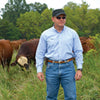 Written By Dr. Allen Williams, Ph.D.
Written By Dr. Allen Williams, Ph.D.
A champion of the grass-fed beef industry and the growing Regenerative Agriculture movement, Allen helps restore soil health, increase land productivity, enhance biodiversity, and produce healthier food. He also serves as Joyce Farms' CRO (Chief Ranching Officer). Learn more about Allen
April 02, 2020 0 Comments
By Dr. Allen R Williams, Ph.D.
As I described in yesterday’s blog, it is getting crazy out there and the panic buying is not subsiding. What is occurring in our nation, and around the world, only serves to substantiate why we need regenerative agriculture now more than ever. It is no longer just about the climate, our water quality, and our ecosystems. They are all still vitally important, but an even more pressing need has emerged.
In the past several decades our agriculture and food systems have become increasingly consolidated and centralized. For example:
Why is this a problem when faced with a pandemic such as the coronavirus? Look no further than your bare local grocery store shelves. Food has to travel more than 1500 miles in the U.S. to get to its final destination of a grocery store or restaurant.
As I explained in my prior blog, we do not have a shortage of food in the U.S., as we have more than 8 billion pounds in frozen stocks. What we have is a transportation problem that is easily overwhelmed.
Centralized food production, processing, and cold storage seem wonderful and awfully efficient when everything is working well. However, when things break down, we find ourselves scrambling for food.
In addition, the larger the farm and the larger the processor, the more people there are that touch your food and everything it comes in contact with. This puts us all at a heightened risk. It's hard not to be in close proximity to your fellow workers in a large, industrial scale food processing plant.
Moving back to regenerative agriculture means we can trend back towards smaller family owned farms that are profitable and support the families that operate them.
This means fewer hands touch the food being produced on those farms. And, more family farms means more local and regional processing. These plants, like Joyce Farms' plant in North Carolina, are substantially smaller than the massive plants operated by the large food companies. That equals fewer hands touching the food in those plants.
Now to be fair, the hands that touch food in any plant, large or small, are gloved hands. But, it is not just hands that transmit viruses - it is the breath of any carrier as well. I am not saying that the big food companies are bad and large plants are bad. No. They have their place. What I am saying is that if they are our only option, we limit ourselves in a number of ways.
Locally and regionally produced food allows for far more options for the consumer. It is easier to transport and get to consumers in a local market. Local and regional production supports rural economies and returns financial stability to the families that live in these rural communities.
More farms practicing regenerative principles equals healthier soil. Healthier soil equals more nutrient dense foods. More nutrient dense foods equals better human health. Better human health equals stronger immune systems and greater ability to fight off challenges like the coronavirus. Better human health is a direct result of supporting a thriving and diverse gut microbiome. That can only come from better foods.
In my next blog I will explain how the gut microbiome is the key to our immune system strength and ultimate health.
 Written By Dr. Allen Williams, Ph.D.
Written By Dr. Allen Williams, Ph.D.
A champion of the grass-fed beef industry and the growing Regenerative Agriculture movement, Allen helps restore soil health, increase land productivity, enhance biodiversity, and produce healthier food. He also serves as Joyce Farms' CRO (Chief Ranching Officer). Learn more about Allen
April 01, 2020 0 Comments
By Dr. Allen R Williams, Ph.D.
We are now experiencing times that many alive today have never been exposed to. We are witnessing our own human condition and our response to something that seems overwhelming and possibly insurmountable. The tangible result is being manifested in widespread panic and fear. Fear that we will run out of toilet paper. Fear that we will run out of food. Fear that our businesses and jobs will implode. Fear that we may contract the coronavirus (COVID-19) and become a statistic.
Across the nation, and in my little town of Starkville, MS, we are seeing grocery store shelves being stripped bare of all paper items (toilet tissue, paper towels, napkins), milk, bread, meats, frozen vegetables, and many other food items. In our hometown Kroger, just yesterday, I saw bare shelves where paper products should have been, where bread should have been, where milk and eggs should have been.
So, why is this happening? Why are people panic buying? Are we in danger of running out of food? Let’s take a brief look at some our actual food stocks in the U.S. Realize that farmers and food processors are still actively engaged in the day to day production of our foodstuffs. Fields are still being planted and harvested, livestock are still being raised and harvested. We have tremendous frozen stocks of many food items readily available in public warehouses.
The January 31, 2020 frozen food stocks in the U.S. are actually staggering. We have 480 million pounds of frozen beef, 563 million pounds of frozen pork, 1.2 billion pounds of frozen poultry (chicken, turkey, duck), just over 1 billion pounds of cheese, and 230 million pounds of butter. In addition, we have 1.1 billion pounds of frozen fruit and 1.8 billion pounds of frozen vegetables. Total food available in frozen storage equals just over 8 billion pounds. With just over 329 million people in the U.S., those food stores amount to 24 pounds of food for every man, woman, and child in the U.S., in just the excess frozen stocks.
So why are we panicking over food? Why do we believe that we will run out sometime soon? It is all because of panic buying. The reason for the bare shelves is not due to a lack of food items, but the inability of our transport system to keep up with the panic buying. We have only so many trucks and so many drivers. They cannot make more deliveries than they currently are.
In this time, it is very important that we not only have food available, but foods that are healthy for us. Foods that feed our bodies the vital nutrients we need to promote strong immune systems and ward off challenges like the flu and coronavirus. That is why we believe so strongly in producing foods through the practice of regenerative agriculture. That is why we believe in pastured proteins. Healthy soils promote healthy foods. Healthy foods promote healthy bodies. Healthy bodies have strong and vibrant microbiomes.
I will close today with a poem from imminent farmer/philosopher Wendell Berry. A poem of encouragement and hope.
When despair for the world grows in me
and I wake in the night at the least sound
in fear of what my life and my children’s lives might be,
I go and lie down where the wood drake
rests in his beauty on the water, and the great heron feeds.
I come into the peace of wild things
who do not tax their lives with forethought
of grief. I come into the presence of still water.
And I feel above me the day-blind stars
waiting with their light. For a time
I rest in the grace of the world, and am free.
Wendell Berry
 Written By Dr. Allen Williams, Ph.D.
Written By Dr. Allen Williams, Ph.D.
A champion of the grass-fed beef industry and the growing Regenerative Agriculture movement, Allen helps restore soil health, increase land productivity, enhance biodiversity, and produce healthier food. He also serves as Joyce Farms' CRO (Chief Ranching Officer). Learn more about Allen
March 31, 2020 0 Comments
Over the years, our Heritage Poulet Rouge® Chicken has become a favorite of award-winning chefs like Chef Jim Noble. But you don't have to be a professional chef to prepare a sensational roasted Poulet Rouge chicken at home.
Chef Noble is currently selling our whole Poulet Rouge chickens as well as our Heritage Ground Beef at Rooster's (in Winston-Salem and Southpark location in Charlotte) and at Noble Smoke in Charlotte.
He has also shared the first in a series of home cooking videos, which features our Poulet Rouge! Check out the full video below, along with the recipe.
1 Whole, Joyce Farms Poulet Rouge® chicken, washed and dried
1/4 lb. Butter
1/4 Cup Olive Oil
1/4 Cup Fresh Herb mixture (parsley, sage, thyme, oregano savory, and rosemary)
1 Cup Cut Vegetables (Brussels sprouts, onions, parsnips, carrots, mushrooms)
1. Preheat oven to 500 degrees F
2. Prep & clean chicken
3. Melt butter and oil on stovetop
4. Spoon melted butter/oil over the chicken and season with Salt and Pepper
5. Roast in oven for 15 minutes
6. Turn oven down to 350 and continue to bake and baste until finished, 30-40 minutes
7. Sprinkle with herbs half way through the roast to keep them from burning.
8. Allow chicken to rest before carving.
March 27, 2020 0 Comments
Please join us for another parking lot sale this Sunday!
WHEN: SUNDAY MARCH 29th from 10:00am - 2:00pm
WHERE: 4787 KINNAMON ROAD, WINSTON-SALEM
Payment options: Cash Preferred, but also accept Credit/Debit Cards
(Please note important traffic instructions at the end of this page)
Stock up on delicious, all-natural, locally raised and produced poultry and meat products for your family and loved ones. This time around, we're offering our popular Naked Chicken Tenders, Whole Heritage Beef Striploins, and our signature Poulet Rouge® Heritage Chicken (raised here in NC, and a favorite of award-winning chefs nationwide!).
Your support helps us keep paychecks going to our employees, keeps our animals fed and farmers compensated, and helps ensure that we are ready to supply all your favorite restaurants once they return to normal!
NO LIMITS ON QUANTITY PURCHASED
We will be offering the products below during the parking lot sale. If we happen to run out of any of these items, we will have similar items available to substitute.



We appreciate all of the calls and messages from folks interested in our next sale, and we've been working diligently to plan this upcoming event with more attention to traffic flow and efficiency. Please take a moment to review the map below, and plan your trip to approach our entrance from 158/Stratford. No left turns off of Kinnamon will be permitted, and Forsyth County Sherriffs will be on-site to help direct traffic.
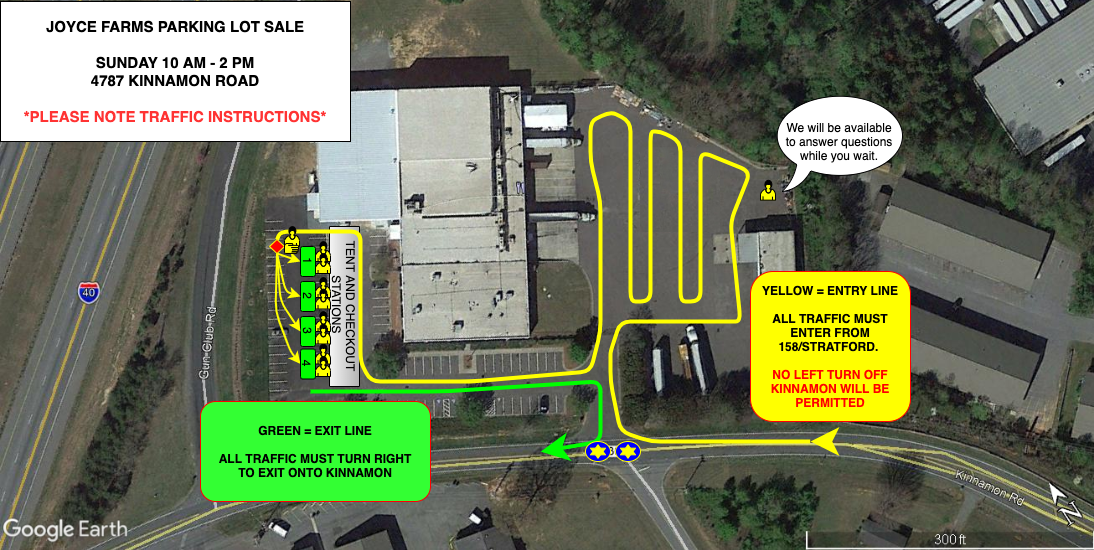
We hope to see you there! Let us know you're coming on our Facebook event page!
March 26, 2020 0 Comments
To Our Customers and Business Partners,
Our world has changed significantly within the past week. The disruption of our daily lives and our businesses has been swift, furious and unprecedented. This is a certainly a challenging time for all of us, both from a human health and an economic perspective.
One of our foremost concerns is the health and well-being of our employees and customers. Our other concern is the economic health of our customers. We hope that all of you will navigate successfully through this crisis, and that you will be able to return to normal business levels as soon as it is safe to do so.
With the $2 trillion virus rescue bill just passed by the Senate and pending in the House, we are hopeful that aid in the form of loans and assistance will be made available quickly to businesses affected by the virus.
Information can be found on the SBA website here: https://www.sba.gov/page/coronavirus-covid-19-small-business-guidance-loan-resources
We at Joyce Farms want you to know that we appreciate your past support of the unique meat and poultry programs we have developed over the years. We remain open to supply you during these trying times, and especially appreciate those of you who continue to place orders with us.
Your support enables us to feed our animals, keep our small farmers in business, and keep a portion of our team employed. Besides, where else would you find meat and poultry with which to make memorable meals? And yes, take-out meals can also be memorable!
From our family to yours, we hope this pandemic will soon be over, that our lives will soon return to normal, and that we will get back to the business as usual. Stay safe.

Ron Joyce
Joyce Farms President & CEO
January 02, 2020 0 Comments
Choosing a New Year's resolution can be challenging, and many of us tend to repeat the same ones each year, hoping for the best. In fact, research indicates roughly 60% of us commit to resolutions, but only about 8% stick to our goals after the ball drops.
Many of the tried and true resolutions we choose are to better our own lives, and without much repercussion, if we fall back to our old ways. This year, we ask that you consider a different kind of resolution, one that will not only improve your own life, but that can impact the future for entire generations.
As we close 2019, food production and environmental well-being have never been more threatened. Centuries of industrial agricultural practices have left us on the brink of environmental disaster, with eroded and unhealthy farmland, contaminated water sources, increasingly severe weather events from an unbalanced ecosystem, and significantly lower food quality. In our attempts to fight these problems, we ended up with more chemical use, more bare and tilled soil left exposed to the elements, and unhealthy modern animal breeds raised to grow extremely fast in confined and inhumane environments.
If industrial, and even sustainable farming practices continue, the United Nations estimates that we would only have about 60 years of farmable topsoil left. With 95% of our food coming from topsoil, it’s clear that change is needed, and that change is regenerative agriculture.
Regenerative Agriculture is a farming method that applies sound ecological principles and biomimicry to regenerate living and life-giving soil. Regenerative agriculture relies on nature, not harsh chemicals or disruptive practices like tilling.

If we restore the health of our soil ecosystem, we restore our own health, the health of our farms, our communities, and our planet. When a farmer is practicing true regenerative agriculture, we like to say, “You know it when you see it.”
What do we see? The return of beneficial insects and pollinators, like bees, dragonflies, grasshoppers, and butterflies. The return of birds such as ground-nesting birds, song birds, migratory birds, and waterfowl. The return of wildlife such as deer, raptors, turkey, and many other furry creatures. The return of soil that actually infiltrates water and restores and recharges our underground aquifers, natural springs, and waterways. The return of a diverse plant species population.


Regenerative agriculture offers a multitude of benefits for our farms, our environments, and our food, including (but not limited to):
So, in 2020, make a resolution to support the Regenerative Agriculture movement.
Here are four simple ways you can do that:
One thing you can do to pursue your resolution is to learn more about regenerative agriculture, the basic principles and terms, and how it differs from industrial and sustainable methods. By arming yourself with knowledge, you will be in a much better position to support regenerative farming in other ways.
Here are several resources to start with:
Maybe it’s unrealistic to say you will only eat or serve regeneratively raised products. Depending on your resources, it could be done, but why not start with something more achievable?
Challenge yourself to use regeneratively raised products a couple of times a week. Chances are, once you start, you won’t want to go back to industrially or even sustainably raised products that lack natural flavor and nutrients.
If you’re a chef, start by adding a couple of regenerative products to your menu, or as a special feature. Make sure you let your customers know what makes it so special!
Once you’ve made the choice to support regenerative, the question becomes, how do I find regenerative products?
Our advice is not to rely on claims, but to engage with farmers and producers directly. Regenerative farming is a complex system, and there’s no “set and repeat” formula that is right for all farms, so it’s important to get to know the farms that produce the food you purchase. Find out what they mean when they say regenerative. Are they just composting on overgrazed land, or have they embraced all of the principles, like livestock integration, and adaptive multi-paddock grazing? Ask about their regenerative practices, or to see them in action if possible. Most farms and organizations that are truly embracing regenerative agriculture will be eager to share with you and welcome you to their farm(s)!
You may be thinking… if regenerative agriculture is as good as we say it is, why isn’t everyone using it? One of the biggest reasons is because people don’t know about it. A second major reason for farmers not transitioning to regenerative agriculture is simply fear. Fear of peer pressure from neighbors, friends, family, and suppliers if they decide to farm differently. Fear of the mountain of debt most farmers carry. Fear of doing something very different than what they have traditionally done. This fear is real and prevents farmers from doing what they should.
Regenerative agriculture is just beginning to seep into the mainstream conversation. The more educated advocates are out there, the faster we can make progress.
Talk about regenerative agriculture with your friends, your family (it makes a great holiday table topic!), the restaurants you frequent, and your social media connections. If you’re a chef using regenerative products, brag about it on your menu! It’s our responsibility to keep the dialogue going about regenerative, what it can do for all of us, and offer support to those farmers moving to regenerative or seeking a transition.
As part of our efforts at Joyce Farms, we introduced educational farm tour events and presentations to help grow awareness, but it could be as simple as a conversation or reposting content on social media!
If you don’t have experience farming or working with soil, now is a great time to start! Take up gardening in your own yard or community garden, or, look into opportunities to volunteer at a local farm. Getting some first-hand experience with the land will give you more context and understanding as you learn about soil health and other regenerative concepts.
Happy New Year from all of us at Joyce Farms!
October 31, 2019 0 Comments
Americans buy more and more grass-fed beef every day. The growing trend stems from increased demand, among chefs and consumers alike, for foods with improved nutritional value, better flavor, and raised with respect toward animal welfare and positive environmental impact.
Unfortunately, in the race to satisfy the burgeoning demand, some grass-fed beef producers and processors have resorted to tricks and shortcuts. As a result, the industry has fragmented into a variety of grass-fed beef production methods – and not all are created equal.
When you buy a product labeled as "grass-fed beef produced in the USA," you probably assume the cattle were raised exclusively on pasture in America, eating a diet of actively growing forages and forage supplements, using environmentally responsible farming methods.
The truth, however, is not always so picturesque.
By learning about the different types of grass-fed beef producers, and the shortcuts some of them take, you will be in a much better position to choose grass-fed products that not only offer the flavor and health benefits you expect, but that you can feel good about buying and consuming.
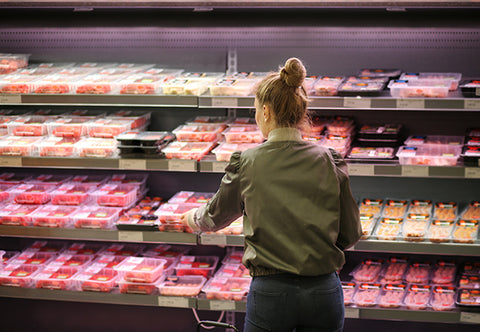
Grass-fed beef production models in America now fall into three categories: Imported, Low Integrity Domestic, and High Integrity Domestic.
Imported grass-fed beef generally comes from South America or Australia/New Zealand. The main benefit of imported grass-fed beef for producers and processors is that it is inexpensive.
It may seem counterintuitive that a perishable product can be shipped on ocean freight across the globe and still be lower in cost than a domestic product. In order to understand this, you must acknowledge that in other countries, grass-fed production is the commodity production method. That simply means there’s nothing special about the beef!
Imported grass-fed beef producers take whatever cattle they can find, graze them in massive herds, and process the beef in an area with fewer regulations and lower labor costs. It is actually cheaper (per pound of beef) to ship containers of imported beef by ocean freight than to ship from state to state in the U.S.
Importers know that you don't want imported grass-fed products, so they hide behind loopholes in the labeling regulations. They will import the beef in bulk, and once it reaches America, they further process and re-pack the beef in a USDA- inspected plant. Voilà – you have a package of grass-fed beef that can legally be labeled “Product of USA.” Tricky, isn’t it?
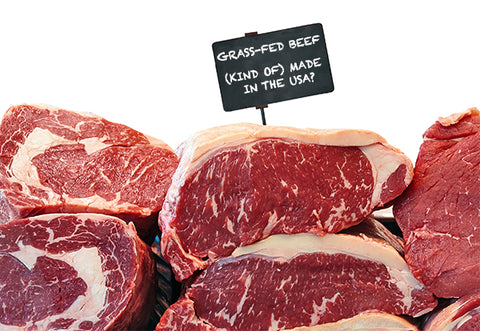
Our second category includes domestic producers of low integrity. The integrity referenced here is not that of dishonest business practices, but dishonest farming practices.
When raising high-quality, truly grass-fed beef, it's critical to use cattle that are genetically built for a 100% grass-fed diet. Low-integrity domestic producers ignore that, using whatever source of cattle they can find. These could be mature animals that are too old to be of value to a feedlot producer, or they could be cull cows coming from a dairy operation or a beef cow-calf herd.
Cull cows are a byproduct of breeding and/or milking operations. They may technically be grass-fed (they may never have been fed grains), but they were never intentionally raised for superior eating quality, flavor, or positive environmental impact. The taste, texture, and tenderness are sub-par, but producers attempt to hide those downfalls by offering the product as ground beef.
Low integrity producers may also buy cattle at auction, which will always be a risk because the seller knows there is a premium to be gained by selling the animals as "grass-fed." There are sellers who are even willing to fraudulently sign documents claiming the animals were grass-fed, even when it cannot be verified or substantiated. The low integrity producer is willing to accept that documentation at face value and has no desire to learn if the purchased livestock were legitimately grass-fed or not.
Low integrity producers also include feeding companies, or "feeders," as they are known in the industry.
Feeders operate large feedlot operations, in which livestock are placed into dirt pens of various sizes. The animals cannot graze, simply because there is nothing to graze in a dirt pen! Instead, formulated rations (called TMRs) are mixed at the feedlot and distributed in a trough at each pen.
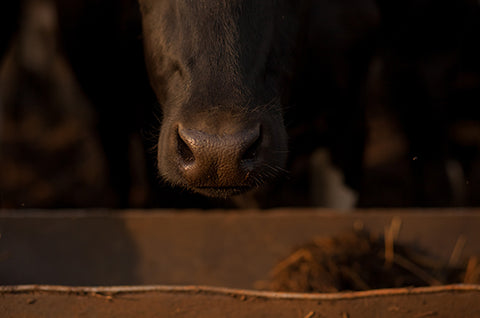
The cattle are not grazing growing plants. Furthermore, the rations barely resemble a plant. There are no leaves, stalks, or flowers, but instead a pellet or mash of plant-based materials. This pellet may be an “everything but the corn” blend that includes grain silage, sugars, palatants (flavorings that make the feed more desirable to the animal), minerals, and pharmaceuticals. It could also include Dried Distillers’ Grains (DDGs), a byproduct of ethanol production, where the grain is distilled for ethanol, dried, and sold as a livestock feed. When DDG’s are used, the grass-fed beef is not truly grass-fed at all; the cattle are consuming a grain byproduct.
The treat of the grass-fed production world!
High-Integrity Grass-Fed Beef producers are those that use honest and ethical farming practices, with the utmost respect for the land, the animal, and the quality of the final product.

Joyce Farms Heritage Aberdeen Angus Grass-Fed Beef, USDA Prime
High integrity production is authentic grass-fed. It is the product that you picture in your mind when you think of grass-fed beef - it's what you expect to receive when you pay a premium, grass-fed beef price. The animals are always on pasture, they eat grass/forage and forage supplements exclusively, and they are never confined to feedlot dirt pens.

Joyce Farms Heritage Aberdeen Angus cattle on pasture in North Carolina.
There are no tricks or shortcuts when it comes to high integrity grass-fed beef production. In fact, it is a series of building blocks. Attention must be given to not only what the cattle eat, but their genetic makeup, the mix of plants they consume, stock density, and grazing patterns. The devil is in the details!
The first building block is superior livestock genetics. High integrity production resulting in a high-quality eating experience must start with superior cattle genetics.
In the past several decades, commercial cattle genetics have been bred specifically for feedlot production; but even the best commercial genetics simply cannot produce high-quality beef on a 100% grass-fed operation. The animals are too large and are not good grazers.
Instead, high integrity grass-fed beef producers use more moderately framed cattle, bred specifically for grass-fed production. These calves are not as numerous and can be more costly to purchase.
The second building block is the forage. High integrity producers will never graze cattle on a monoculture forage. Instead, they will graze livestock on diverse pastures offering many different species of grasses, legumes, and forbs. This variety is of paramount importance for the palatability and nutritional value of the finished beef, and for the health of the cattle.
The third building block is the grazing plan. Many grass-fed beef producers will throw around buzz words like “mob grazing” and “Serengeti method," but the truth is that most grazers don’t actually follow through with any grazing plan. Proper grazing management must be adaptive in nature and practice.
Nature and biology are never static, and grazing can't be either. Adaptive grazing involves frequently moving cattle from one pasture to the next, monitoring the available forage in each pasture, and using keen observation to anticipate and prepare for changes in weather, season, and the size of the herd. Many techniques must be implemented to be an effective grazer, but a written plan is only as good as its execution.
The fourth building block is the most important of all - without it, nothing else matters. That building block is soil health.
To produce grass-fed beef, you need grass, and you can't have grass without healthy soil. Healthy soil is vibrantly alive with billions of microbes per gram of soil, thriving with insects, and resilient to nature’s challenges.
The soil in our nation’s farmland has been damaged by generations of misguided farming practices. The rampant use of tillage, chemical and pharmaceutical problem-solvers, and ineffective synthetic fertilizers have taken abundantly fertile land and transformed it into a man-made desert.
Thankfully, the damage is repairable...with the right farming practices. The solution to fixing soil health and protecting our food system for future generations is Regenerative Agriculture.
Regenerative Agriculture is a surprisingly simple method of farming that cooperates and collaborates with nature, rather than trying to “tame” or fight it. Regenerative practices repair, restore, rebuild, and regenerate the soil, rather than degrading it (like industrial agriculture) or even maintaining its degraded state (like sustainable, organic farming). The truth is, we can never be sustainable, and with so much already-degraded land in our nation, why would we want to?
Regenerative Agriculture is a journey, not a destination, but there are six principles that can be implemented universally. You can learn about them here.
By using labeling tricks and legal loopholes, Imported Grass-Fed Beef Producers and Low Integrity Domestic Grass-Fed Beef Producers put the entire grass-fed beef industry at risk of rattling public confidence.
There may be a need for more than one kind of grass-fed production system, but if that's the case, they should all be honest and transparent to the end user.
Next time you are searching for a grass-fed beef product, don't just rely on labels and claims. Get to know the farmers and producers - ask questions about their animals and their practices. If they are ethical in their production, they won't have any reason to hide.
It is up to us, the high integrity producers, to continue to produce a premium product that lives up to the grass-fed expectation -- one that offers the taste, texture, tenderness, and health benefits that our customers expect, with no tricks.
Now that you know more, which kind of grass-fed beef producers will you choose to support?
September 27, 2019 0 Comments
At Joyce Farms we pride ourselves in paying attention to the little things. Even the REALLY little things, like microbes in the soil. The world beneath the soil surface is full of life and incredibly complex, far more so than life above the soil surface. Without their action in the soil, we suffer. When they are present in large numbers and highly active, we benefit.
A single spoonful of healthy soil contains more life than there are humans on Earth.
When it comes to healthy soil, healthy plants, healthy animals and healthy people, the little things do matter --- a lot. That is why our focus on producing flavorful and nutrient-dense food starts with the soil, and not just the soil itself, but those tiny microbes residing in it.
The soil’s population of microbes is diverse, made up of bacteria, fungi, protozoa, and nematodes, and others. For now, we want to focus on one -- mycorrhizal fungi.
Mycorrhizal fungi are microscopic thread-like organisms that play an incredibly important role in healthy soil, and therefore, in the production of truly healthy, nutritious food. We are now discovering how critical that role is, and what happens when they are not present in the soil in large numbers.
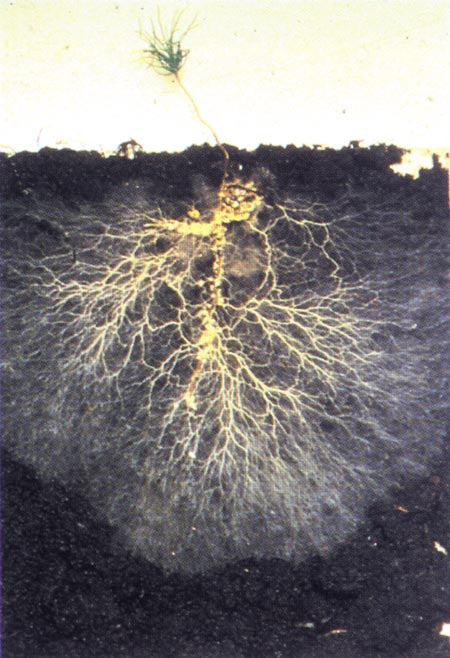
The activities of mycorrhizal fungi beneath the soil surface are just as sophisticated and purposeful as anything we can point to above ground.
Mycorrhizal fungi can create an incredibly powerful, interconnected exchange network between plants... much like the world wide web of soil. When given the chance, and not disturbed by degenerative farming practices, mycorrhizal fungi spread their feathery tendrils throughout entire fields, attaching to plant roots, connecting every plant in a web of constant communication and mutually beneficial trades.
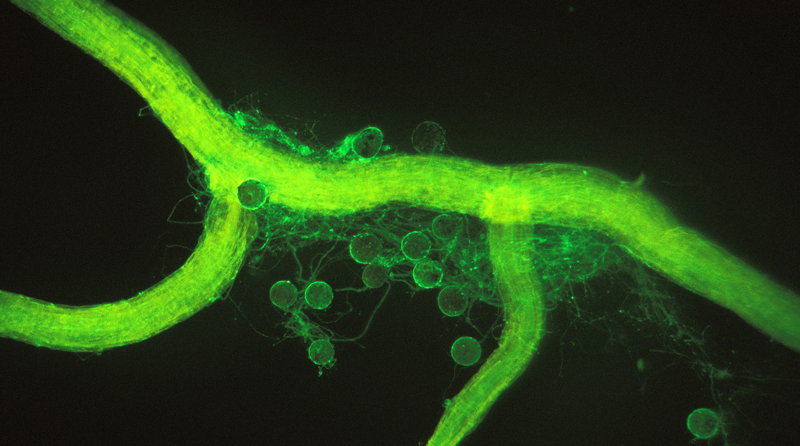
Plants need nutrients from the soil, but most of those nutrients are 1) out of reach of the plant roots, and 2) bound in the soil and must be dissolved before the plants can absorb them. Mycorrhizal fungi can help. They can greatly extend the reach of the plant roots, and also produce powerful enzymes that break down nutrients and transfer them to the plant… but only for a price.
The mycorrhizal fungi want to eat too, and they prefer the sugars and fats that plants exude from their roots. So, in exchange for nutrients, mycorrhizae receive plant root exudates that are loaded with carbon (produced from CO2 pulled from the atmosphere during photosynthesis).
Mycorrhizal fungi and plants are able to make sophisticated, spur of the moment decisions about their trades, always negotiating the best “deal” they can. It is the world’s oldest bartering system.
In this delicate dance between plants and mycorrhizal fungi, plants can reward high performing fungi with more sugars and punish poor-performing fungi with less sugars. Fungi can also give more nutrients to plants that “feed” them more sugars.
Mycorrhizal fungi can "feed" more nutrients to a plant when it is “paying” them well, or they can store or "hoard" nutrients and wait for a better offer (either from that plant or other plants) before they release the nutrients.
For example, in one experiment, carrot roots and fungi were grown together in a petri dish divided into three equal compartments. Interestingly, in one compartment the carrot roots provided the fungi with more sugars than in the other compartments. The carrot that was willing to trade more sugar with the fungi received more nutrients in return.
These fungi can also move nutrients back and forth from “rich” regions in the rhizosphere to “poor” regions. In the poor regions, where nutrients are scarce, the plants are willing to pay more carbon-rich sugars to get them from the mycorrhizal fungi. Through this feedback system, soils that are lacking nutrients can quickly increase their nutrient availability through this mycorrhizal pathway. Nutrients flow both ways, too. Research shows nutrients oscillate back and forth through the mycorrhizal network every five minutes at precise timing.
As mycorrhizal fungi are forming their network, they use a sticky biotic glue called glomalin to attach to plant roots. Not only does this connect plants together over the fungal “exchange network,” it also binds tiny soil particles together into larger clumps of soil called aggregates.
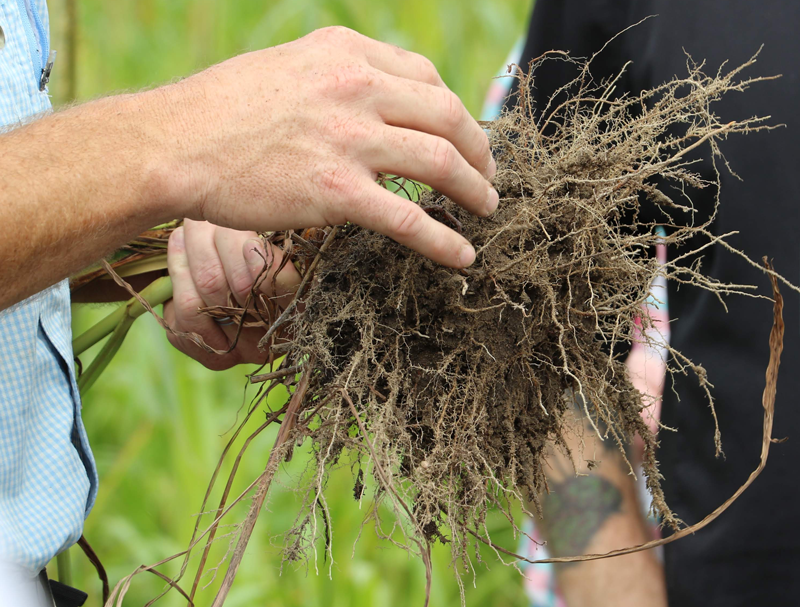
When the soil is aggregated, it allows for increased oxygen and water infiltration. Without aggregates, rain pools on the soil surface, then runs off, eroding the soil and carrying tremendous amounts of topsoil, nitrates, phosphates, and harmful agricultural chemicals with it.
Mycorrhizal fungi also protect plants from drought by storing an “emergency fund” of water, for not-so-rainy days. Since mycorrhizal fungi can actually penetrate plant roots, they are able to directly place water molecules inside the plant roots for use in periods of dry and drought conditions.
However, like many other functions performed by mycorrhizal fungi, there is a selfish motive involved. They want to be fed during periods of drought, too. So, by placing the water molecules inside plant roots, they assure themselves that the plants have adequate survival to continue to supply them with steady meals of carbon-rich root exudates.
Different plant species produce varying arrays of what are called plant secondary and tertiary nutrient compounds, which are medicinal in nature and promote disease resistance and pest resistance in other plants. They also provide medicinal benefits to animals and humans.
These compounds are transferred from plant to plant via the mycorrhizal highway. Without this occurring, plants are far more susceptible to fungal diseases and to pest insects. In fact, mycorrhizal fungi are the principal immune system for plants against fungal root diseases.
In the past several decades, the use of fungicides by farmers has increased significantly, because typical agricultural practices (like tillage) destroy mycorrhizal fungi populations. In addition, the fungicides used to combat plant fungal diseases are not organism-specific, so they kill not only the target disease-causing organisms, but also the mycorrhizal fungi. This leads to continued disease, and continued use of fungicides, which becomes a vicious cycle.
That is why we practice Regenerative Agriculture at Joyce Farms.
By eliminating tillage, we stop the destruction of the mycorrhizal fungi. By implementing practices such as diverse cover crops instead of perpetual monocultures, and adaptive livestock grazing that stimulates mycorrhizal populations, we not only reduce, but eliminate the need for fungicides. We escape the vicious cycle and turn things back over to Mother Nature.
Soil microbes truly are the foundation of all health, both below the soil surface and above. More than 80% of all plants existing in the world today have developed relationships with fungi. Still others have relationships with bacteria in the soil. If we were to purge the soil of microbes, we would also purge the soil of plants, and purge our world of the ability to produce food.
Implementing agricultural practices that damage or destroy these soil microbes is only doing harm to ourselves and all life around us. Conversely, implementing true regenerative practices that foster, facilitate, encourage, and stimulate these soil microbes provides immense benefits -- our soil is healthy, our crops are healthy, our livestock are healthy, we are healthy, our ecosystems are healthy, and our climate is healthy.
These tiniest of creatures hold the key to solving the primary issues we face today that seem so daunting. If we simply provide for them, they will provide for us. That is why regenerative agriculture and soil health is so important to us at Joyce Farms, and why it should be important to you, too!
July 25, 2019 0 Comments
We are all familiar with erosion and the soil’s ability to wear away, but few people associate soil with growing upward. The truth is, just like we can use poor farming methods to cause erosion of topsoil, we can use regenerative farming methods to literally grow new topsoil!
Regenerative farming depends on an active and balanced carbon cycle, through which plants, soil, and grazing animals create a circle of life that is powered by sunshine. When the carbon cycle is active and balanced, there is a continuous flow of new, carbon-rich organic matter to the soil.
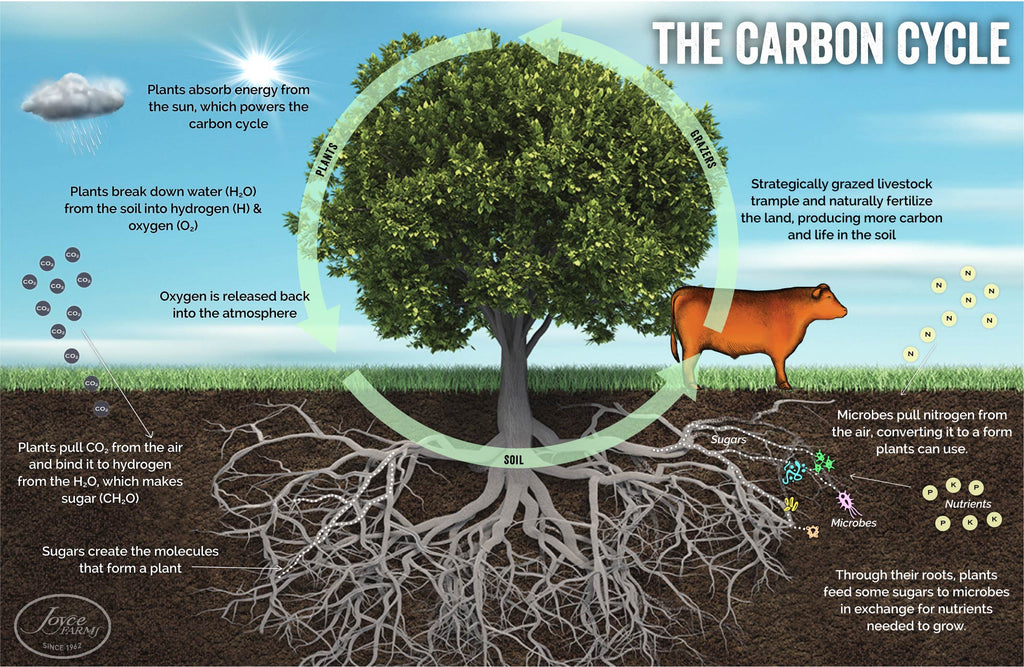
Plants capture energy from the sun and carbon dioxide from the atmosphere. Next, they use water and minerals from the soil to produce sugars. Some of those sugars are shared with soil microbes in exchange for mineral nutrients. Those root exudates add carbon-rich organic matter to the soil. Grazing animals keep the cycle going (more on that in a minute).
The question is - when all that new, carbon-rich organic matter is added to the soil, where does it go?
Soil is porous. You may naturally assume that any added organic matter would fill the existing pores or holes in the soil, making it more and more solid. If this were true, and you continued to add organic matter, at some point you would essentially be trying to farm on a slab of rock-hard granite.
The good news is, that’s not how it works.
In reality, soil rich in organic matter is more like a sponge than a slab of rock. It's more porous and holds more water. Carbon-rich soil is not rock-hard, but soft under your feet and easier to penetrate with a shovel. That’s because the soil volume has expanded upward, with the help of Mother Nature.
Here's how it happens:
Through regenerative farming practices, animals graze and naturally fertilize an area of land, trampling plants and other organic matter on the surface as they do.
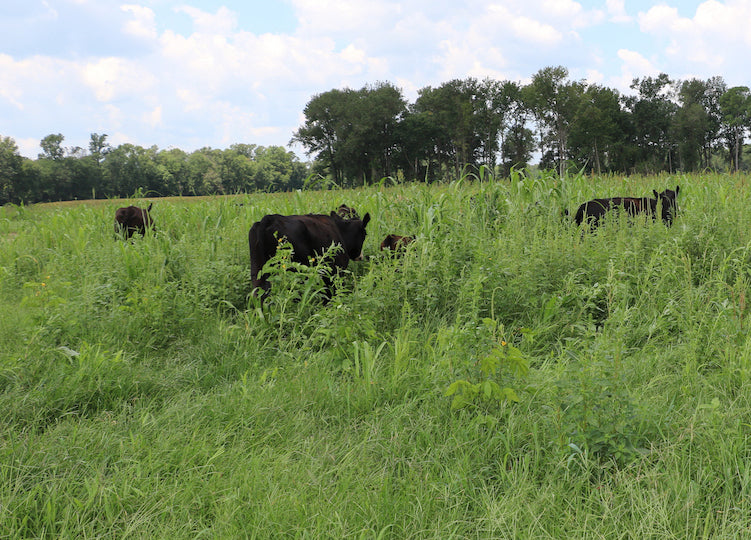
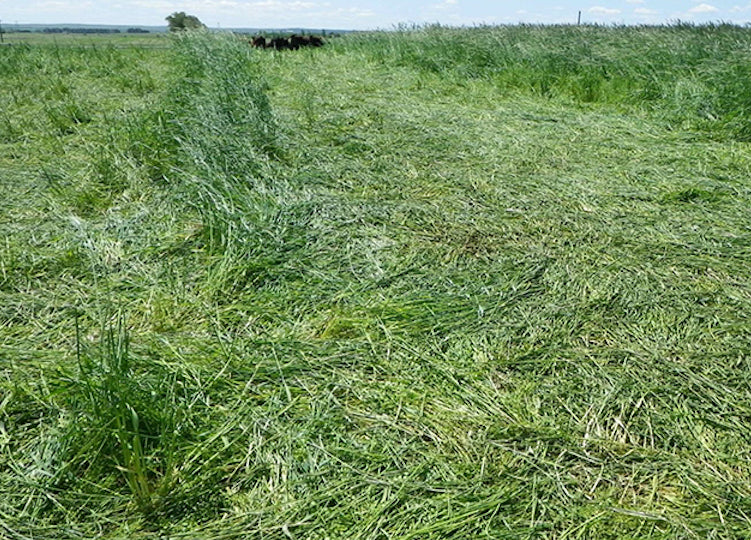
Worms and dung beetles feed on the trampled matter and the manure. They “churn” what’s on the ground and what’s underneath, creating displacement of soil material from below the ground to above it.

Essentially, they excavate the soil from below the ground and put it on top. In the process, new void spaces, or pores, open up in the soil. This new porosity means the soil can hold more water and give access to flowing nutrients.
This is also why you may find a latent seed bank waking up and starting to grow in your soil, long after you thought the topsoil was eroded. This “churning” can carry seeds up near the soil surface, where they can germinate and grow.
The activity of the grazing animals also stimulates the soil microbial population, especially mycorrhizal fungi.

Mycorrhizal fungi produce biotic glues that bind the tiny soil particles together to create much larger particles, opening up significant pore space for water and oxygen infiltration and movement.
So if both organic matter and porosity are being added, and the soil can’t grow down or sideways without compacting, it can only be doing one thing - growing up!
Many experts and even textbooks will tell you that it takes 1000+ years to grow an inch of topsoil, but now we know we can do it much more quickly with regenerative agriculture. Farmers and grazers can add between 0.5% - 1.0% organic matter in a single year.
One of our farmers, Adam Grady, added 3 inches of new topsoil on his farm, in just 2 years!
The photo below was taken on his farm, where our Heritage GOS pigs and some of our Heritage Aberdeen Angus cattle are raised. That line of color separation you see is called the carbon line. The darker soil at the surface is new topsoil that has been grown from increased soil organic matter!

June 11, 2019 0 Comments
On May 31- June 1, 2019, the Starkville Civitan Club hosted their annual Steak Dinner Fundraiser to benefit developmentally disabled children. The event is now in its fifth year, and the steak dinners have become a huge draw for members of the greater Starkville, MS community.
Joyce Farms CRO Dr. Allen Williams is a long-time member and officer of the Starkville Civitan Club. He took on a very important role during the event - manning the grill!
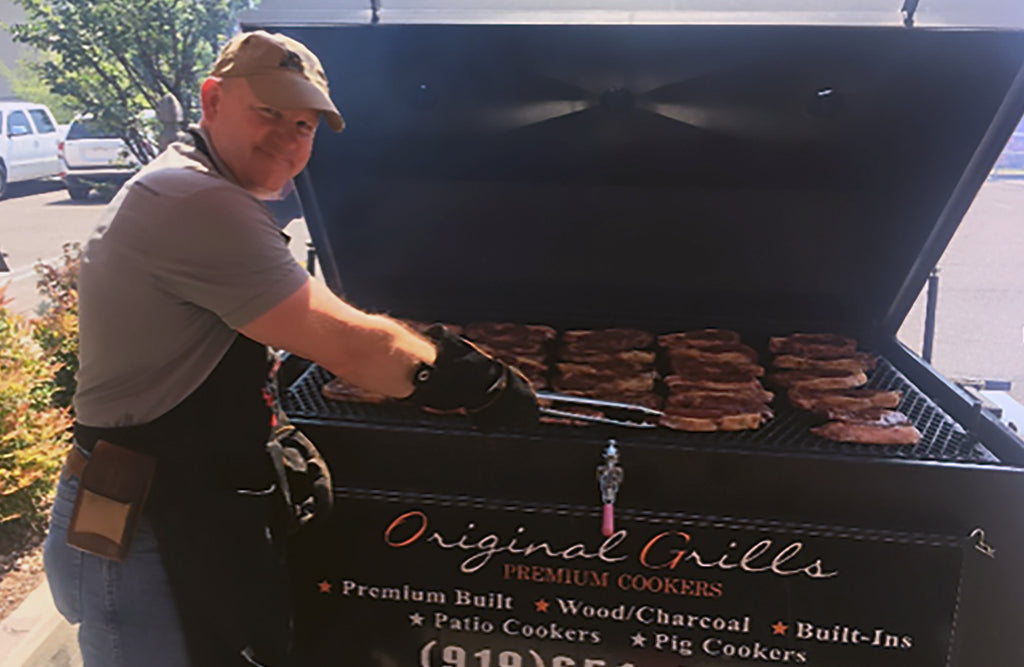
Over the course of the 2-day event, Allen cooked hundreds of steaks to order. His greatest delights were hearing the multitude of satisfied donors rave about the steaks, and knowing that 100% of their financial contributions would support programs and facilities for special needs kids.
The Steak Dinner Fundraiser has become so popular that many in the city of Starkville mark the dates on their calendars and purchase steak dinners not just once over the weekend, but multiple times.
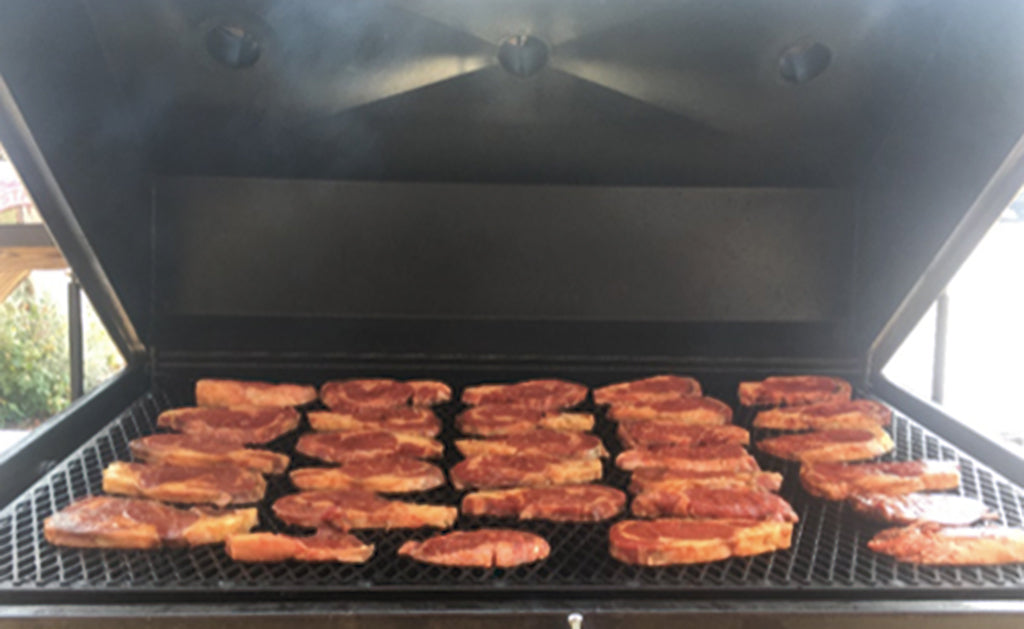
According to Allen, the secret to their satisfaction is the Joyce Farms grass fed beef. He said:
"People always ask just how the Civitan Steaks taste so much better than anything else they can get, even at the best restaurants in the region. I just smile and tell them the secret is in the breed and how the cattle were raised. Regenerative practices on our farms do make that much of a difference!"
Joyce Farms is honored to be a part of this event, and to provide flavorful, nutritious meals to all of the generous donors.
The Starkville Civitan Club is a member of Civitan International, an international volunteer service organization dedicated to helping people in the local community. For more information, visit Civitan.org.
